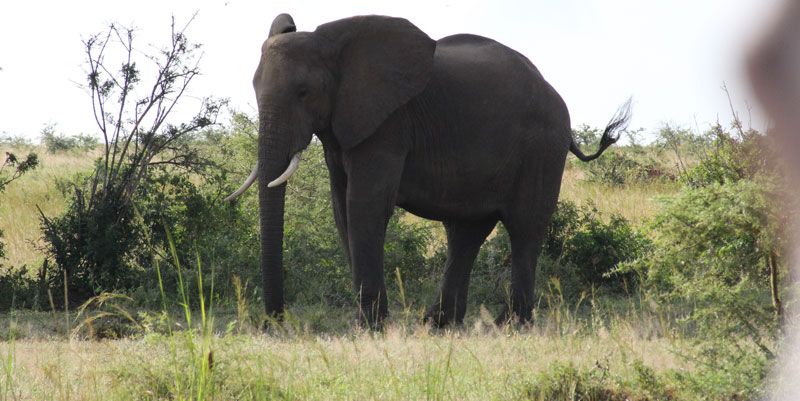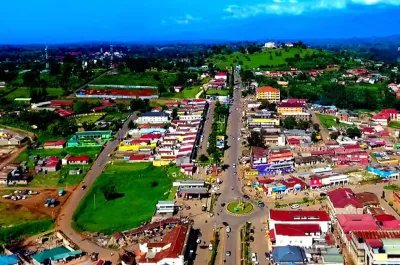
Its 7:45 a.m. A cold breeze from the River Nile lingers as we approach the route to Paraa Safari Lodge. Three elephants flap their wide ears and raise their trunks up as they graze together, six meters away from the entrance to Paraa in Murchison Falls National Park.
A ten minutes-ride from Pakwach town through the bridge in a bumpy rocky-ride gets one to the immediate wildlife view area at the gate where domestic tourists pay 15,000/= for entrance, a rate. Twenty percent of this gate collection goes to the local community as a revenue-sharing fund to compensate when wild animals destroy their crops.
This sunny Thursday morning, the animals seem at peace as they graze at liberty near humans employed to protect them. Except for the wild cats they are hardly visible from the entrance.
The cats are herbivores and according to Sgt. Muranzi Kwezi, the tour guide, and once one has fed on a human flesh, they would attack the whole community because it would not want to eat anything else.
The elephants, giraffes, Uganda kob and hippos seem to have a better part of the 3,800 square kilometer park, the largest among the ten parks in the country.
Eric Enyel, the Senior Warden Murchison Falls National Park, says an aerial census carried out three years ago put the number of elephants at 5,900, 2,300 of which are at Murchison Falls. By 1986, there were about 2,000 elephants only in the park due to the insurgency in Northern Uganda, but the number has since increased due to migration from other countries and natural factors.
Enyel said elephants have a natural instinct that directs them to a particular route as they migrate. They are one of the largest mammals on earth; and are among the most intelligent of the creatures with complex consciousness that are capable of strong emotions.
Weighing between 400-500kgs, standing up to about 5.5 metres tall with a lifespan of about 25 years, an elephant eats about 300 kgs of leaves and trees and drinks about 60 litres of water per day; a reason they are a danger to the farmers in the vicinity.
He adds that the animal-human conflict experienced in the communities, especially around Nwoya, is because their natural routes have been tampered with.
However, Andrew Seguya, the Executive Director of Uganda Wild Life Authority (UWA) believes that if the elephants are confined in one national park as some people think, it will have a genetic effect. “Confining animals in one place will have a genetic effect. It is not the nature of animals to be confined in parks but because we want people to also coexist with the animals, we do so. We only try to control them but you cannot maintain them in the parks all the time.”

Andrew Seguya, the executive director Uganda Wild Life Authority at the Rhino Pool side at Murchison
He explains that if the animal-human conflict is to be cease, people have to respect the migratory corridors of animals like elephants. “We have challenges when animals get into gardens and frustrate people.
It is only proper if people maintain the migration corridors and not settle or grow crops in them. The elephants have used the migratory corridors for centuries and you cannot begin to change that in their minds today.”
Recently, UWA spent about 2.5 billion shillings to compensate communities affected by the wild animals. Seguya says UWA has tried several interventions to cub the animal-human conflict but the trend continues since the elephants are clever animals. “We have a trench to cover the whole of Nwoya up to Kololo in Amuru but the elephants are clever, they follow up to the tarmac because we could not dig the trench to destroy that road.”
He encouraged the locals to continue growing pepper to deter elephants but also benefit from it as an economically viable crop. A kilogramme of pepper costs between 15,000/= to 20,000/= lpcally.
While launching the Tulambule, a promotional local tourism drive at the Hippo pool at Murchison Falls National Park recently, Godfrey Kiwanda Ssuubi, the Minister of state, Tourism, Wildlife and Antiquities urged the locals to use their diverse culture to attract tourists who come to visit the park. “Tulambule is to get more local people inside the park but we are telling Ugandans that you have this heritage to develop. See how you can use them to do business. Make crafts and sell to the tourists to improve your livelihoods.”
He added: “You can do trade within legal means in wildlife products, like farming crocodiles, that is allowed, if you use the right channels; tourists love such as well.”
By 2020, Uganda aims to attract more than four million visitors every year, a target they hope to boost through local tourism. Currently, about 1.5 million tourists visit national parks, accounting for one percent of the sector’s contribution to the national Gross Domestic Product.















Sunrise reporter
Leave a Comment
Your email address will not be published.